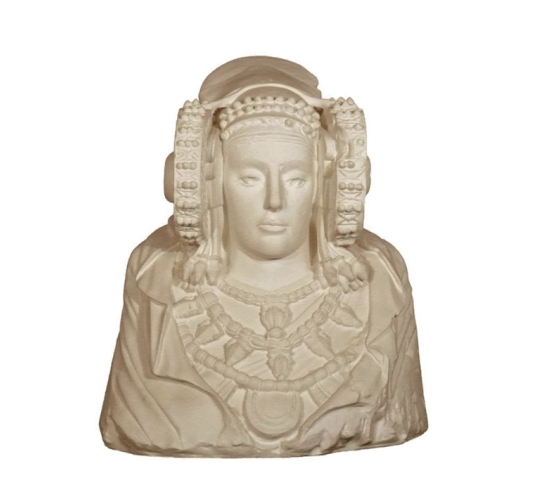- New
The Lady of Elche or the Lady of Elx
The Lady of Elche (Dama d'Elx in Valencian; Dama de Elche in Spanish) is a limestone bust sculpture of a woman, dated to the 5th or 4th century BC, discovered on August 4, 1897 on an ancient Roman site in Alcudia, 2 km south of Elche, near Alicante, Spain.
The sculpture is 56 cm high and has an almost spherical cavity in its back, 18 cm in diameter and 16 cm deep, which may have been used to insert relics, sacred objects or ashes as offerings to the deceased. Many other Iberian figures of a religious nature, located in other places, also have a hollow in their backs and, like the Lady of Elche, their shoulders are slightly bent forward.
The piece was found near Elche, Spain, where there is a small mountain that the Arabs called Alcudia (mound), which in ancient times was almost entirely surrounded by a river. It is known to have been an Iberian colony called Helike (in Greek) and that the Romans called Illici Augusta Colonia Julia. When the Arabs came in their turn, they keeping however the Roman toponym of Illici, which was Arabized in Elche.
Discovered in 1897 near Alicante, the Lady of Elche, a masterpiece of Iberian art, was bought by the Louvre Museum and returned to Franco's Spain in 1941. This exceptional sculpture, dating from the 5th or 4th centuries B.C., still raises many questions for researchers. This bust is currently kept at the National Archaeological Museum of Spain in Madrid. It is the best known and most important archaeological remains of the Iberian culture.
Dimensions
Height: 22.44 ".
Width: 19.68 ".
Depth: 13.78 ".
Weight: 40 kg (88.18 lbs)
Material: reconstituted marble (marble dust + high density resin).
In stock
Delivery time: Delivery within 15 days to 25 days.
Shipping: Transport costs are automatically calculated when you finalize your purchases at the checkout.
The costume of the Lady of Elche is unquestionably of Iberian style. She wears a blue tunic of fine linen, a mantilla supported by a comb (which may be a tiara), which falls across her chest. This mantilla was reddish and even contained remains of worn paint. A large cloak (mantle) of thick, heavy canvas covered it. It was brown with a red border. The lips also retained reddish remains.
The original sculpture is made of fine orange limestone and the face has the natural colour of this stone, probably the natural colour of her complexion.
The Lady of Elche wears jewels characteristic of the Iberians: circles that cover her ears from which hang small chains tied to a leather strap that encircles her forehead. Necklaces and crowns with small spheres and watermarks. These are reproductions of jewellery that originated in Ionia in the 7th century BC and later arrived in Etruria (Italy). At the last analysis, a small fragment of gold leaf was found in one of the folds of the back.
This leads to the assumption that the jewels of the sculpture were covered with gold leaf.
Place and date of discovery
The bust of the Lady of Elche was discovered on August 4, 1897. The workers were clearing the south-eastern slope of the hill of La Alcudia for farming purposes. According to local legend, Manuel Campello Esclápez, known as Manolico, a 14-year-old boy who helped with the tasks, was the discoverer.
Using Antonio Maciá's peak, and taking advantage of a break from the day labourers, he began to dig. With a hoe, he realized that he had stumbled upon something hard that was not earth (the hoe mark can still be seen). He called for the men and they all began to scratch the sand. Thus the bust of the Lady of Elche appeared. Since then, she was baptized by Manolico, the Moorish Queen.
The place where the bust of the Lady of Elche was discovered is now an archaeological site where, over the years, many valuable Iberian and Roman artefacts have been found, testimony to these civilizations. An Iberian-Punic village, Roman sewers, mosaics and a lamp with the effigy of Saint Abdón have been discovered here, which belong to an early Christian basilica that is thought to date from the 5th century. This last archaeological testimony is supported by the codices of the Councils of Toledo, which mention the bishops present from Illici (Elche).
